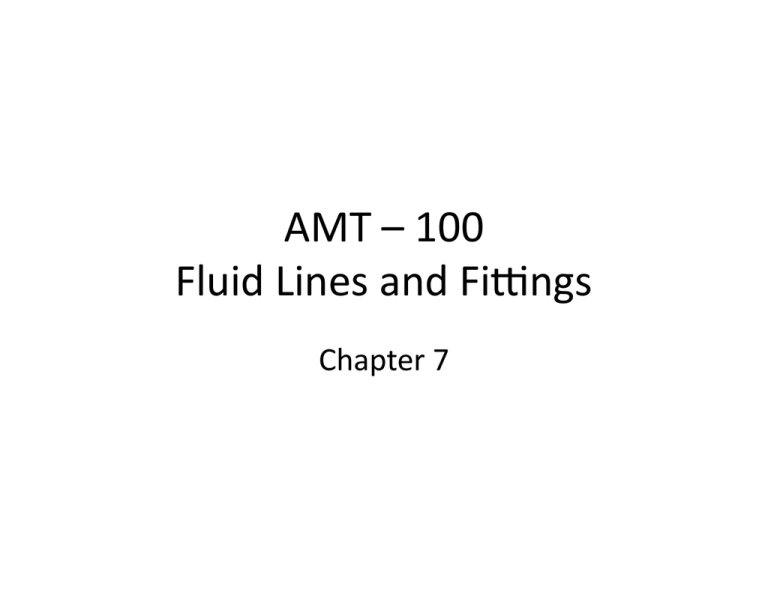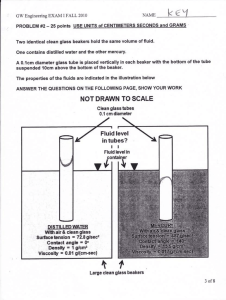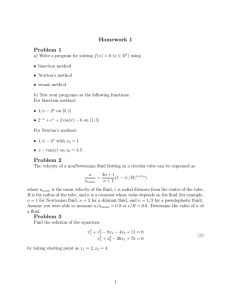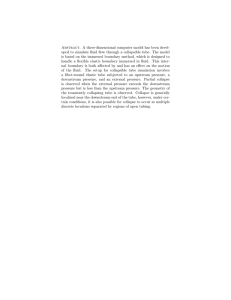Document 13698562
advertisement

AMT – 100 Fluid Lines and Fi2ngs Chapter 7 • Used for: Fluid Lines Hydraulic fluid Fuel • May have insulaCon/protecCon Fire exCnguishing agent Compressed air Drains Instrument air -­‐ pitot and staCc air Rigid Fluid Lines • Used where there is no relaCve moCon between the tube and the aircraM • Made of: Aluminum • Half-­‐hard 1100 or 3003 Fuel lines, engine oil and instrument air • 2024-­‐T or 5052-­‐0 Medium pressure hydraulic systems • Made of: Rigid Fluid Lines Corrosion-­‐RESistant steel (CRES or stainless steel) • Annealed or 1/4–hard CRES High pressure (3000 psi and higher) hydraulic fluid Harsh environments • Uses MS flareless fi2ngs or swaged fi2ngs Copper • Work hardens with Cme • If found, replace Titanium • High pressure applicaCon • Don’t use with oxygen Reacts with oxygen Rigid Fluid Lines Size • Sized by outside diameter • Available in 1/16” increments • Inside diameter = outside diameter – 2 X wall thickness • Example: #10 with 0.065” wall thickness Outside diameter = 10 X 1/16” = 10/16” = 5/8” Inside diameter = 5/8” – 2 X 0.065” = 0.495” Rigid Fluid Lines Size RelaConship between fluid line size and its outside diameter. Rigid Fluid Lines Cu2ng • Cut must be square and burr free • Use tube cufer Hacksaw and cu2ng wheels should not be used on aluminum Fine tooth hacksaw or abrasive wheel should be limited to CRES • Deburr inside of tube • Use fine sandpaper to polish outside end Tube Bending Tube Bending • Bending must maintain 75% of the tube diameter • Small thin wall tubes (1/4” or less) can be bent by hand with special coil bending spring • Bend with fill: • Fusible Alloy -­‐ low melCng point of 160 degrees. Boil in water, melt, pour in tube, bend tube and boil the metal back out • Fill with sand and block off ends • Frozen soap soluCons Tube Bending • Large tubes must be bent with bending tools • Wrinkles, kinks, cracks and flafening are causes for rejecCon • Make a model of the layout with welding rod • Blend the tool marks to smooth • Maintain minimum bend radius For the same size tube, CRES will requires a larger bend radius • At least one bend for stress relief Tube Bending Tube Beading • Connects two rigid tubes • Provides stress relief • Used for low pressure applicaCons Tube Beading Tube Beading Tube Flaring • Flare at a 37° angle AutomoCve uses 45° • 1/8 to 3/8 5052-­‐0 and 6061-­‐T tubes must use a double flare More resistant to damage when the joint is Cghtened • Minimum diameter of a flare is the small part of the sleeve • Maximum diameter of a flare is the large part of the sleeve Double Flare Single Flare Proper flare dimensions. Flared Tube End Fi2ngs • Two types: Single piece – AN817 nut • Should not be used near bend Two piece – AN818 nut and AN819 sleeve • Reduce wiping or ironing acCon on flare • Over Cghtening a flared tube coupling nut will likely weaken or damage the tube and it is most likely to fail at the sleeve and flare juncCon Flared Tube End Fi2ngs • No tension on tube while Cghtening nut • PressurizaCon will cause tube to expand and shiM • Put fi2ngs on before flaring tube Flared Tube End Fi2ngs MS Flareless Fi2ng • Used for high-­‐pressure hydraulics and pneumaCcs • Consists of body, sleeve and nut • Use hydraulic fluid to assist in assembly • Tube must be preset before fi2ng is installed • MS flareless fi2ngs are installed by hand Cghtening and then turning 1/6 to 1/3 turn (one to two nut faces) No torque value used MS Flareless Preset MS Flareless Preset MS Flareless Preset • Preset Cghtening depends on tube type & size Aluminum 1/2” and less • Tighten 1 to 1 1/6 turns (1 turn plus a nut face) Aluminum over 1/2” and steel • Tighten 1 1/6 turns (1 turn plus a nut face) to 1 1/2 turns (1 turn plus three nut faces) Swaged Tube Fi2ngs Tube Flaring Sequence Tube Flaring Sequence Put nut and sleeve on tube Place tube in flaring block Center the plunger Project the end of the tube slightly from the top of the flaring tool, about the thickness of a dime • Tighten the clamp bar securely to prevent slippage • Strike the plunger several light blows with a lightweight hammer or mallet and turn the plunger one-­‐half turn aMer each blow • • • • Rigid Tube Damage • Scratches or nicks on the straight porCon of aluminum alloy tubing may be repaired if they are no deeper than 10 percent of the wall thickness • Scratches and nicks should be burnished out of the tube, to prevent stress concentraCons InstallaCon of Rigid Fluid Lines • Fluid line should be installed below a wire bundle to prevent a leak we2ng the wires • Each secCon of rigid tubing must have at least one bend in it to absorb vibraCon and the dimensional changes • The tubing should fit squarely against the fi2ng before the nut is started • Metal fluid lines are installed in an aircraM with cushion clamps InstallaCon of Rigid Fluid Lines • Metal fluid lines are installed in an aircraM with bonded cushion clamps Bonded clamps have a strip of metal inside the cushion that electrically connects the tubing to the aircraM structure To provide a good electrical connecCon, remove all of the paint and the anodized oxide film from the locaCon to which the clamp is fastened Distance Between Supports AC 43-­‐13-­‐1B Sec0on 8-­‐31 Minimize Overhang InstallaCon of Rigid Fluid Lines Correct and incorrect ways of installing the clamps to hold fluid lines. InstallaCon of Rigid Fluid Lines • EAA clamp video Grommets Bonded Clamps Repair of Rigid Fluid Lines • Scratches and nicks that are no deeper than 10% of the wall thickness of a piece of metal tubing can be repaired by burnishing • Tubing containing damage in the heel of a bend must be replaced • Dents that are less than 20% of the tube diameter are permissible • Flafening of tubing by not more than 25 percent of the original diameter is permissible Comes from “Bending must maintain 75% of the tube diameter” Repair of Rigid Fluid Lines Repair with a Swage A. A pinhole leak may be repaired with a single swaged fi2ng. B. An extensively damaged tube may be repaired by cu2ng out the damaged area and splicing in a new secCon of tubing using two swaged fi2ngs. IdenCficaCon of Fluid Lines • Rigid tubing is marked with colored tape and symbols to idenCfy its contents. • Symbols are always black against a white background regardless of line content. IdenCficaCon of Fluid Lines Rigid tubing idenCficaCon. Hazardous Fluid Labels IdenCficaCon of fluid lines carrying hazardous fluids. • Used for: Flexible Fluid Lines ConnecCng components that move InstallaCons in which the line must be frequently connected and disconnected • Reminder: Use only the manufacturer’s recommended hose or an approved subsCtute • Flexible hoses have a lay line printed along the outside Use the lay line to insure the fluid line is not twisted • All flexible hose installaCons should be supported at least every 24” Flexible Fluid Lines Sizing • Specified in 1/16” • Represents the approximate inside diameter of the line • The size is a refers to the outside diameter of a rigid tube that has the equivalent flow characterisCcs • The actual inside diameter is smaller than the sizing number indicates This compensates for the wall thickness of a rigid tube Flexible Fluid Lines • Low-­‐pressure hose MIL-­‐H-­‐5593 SyntheCc rubber inner liner, a cofon braid, and a syntheCc rubber outer cover Maximum pressure of 300 psi IdenCfied by a broken yellow lay line; the lefers LP; and the manufacturer's code number and date marking Flexible Fluid Lines • Medium-­‐pressure hose MIL-­‐H-­‐8794 Seamless syntheCc rubber inner line; a syntheCc rubber-­‐impregnated cofon braid reinforcement; and a steel wire braid reinforcement; encased in a rough syntheCc rubber-­‐impregnated cofon braid Maximum pressure of 1,500 psi Flexible Fluid Lines • High-­‐pressure hose MIL-­‐H-­‐8788 Seamless syntheCc rubber inner tube; either two or three carbon steel wire braid reinforcements; and covered with a smooth syntheCc rubber cover Pressure range of 1,500 to 3,000 psi Flexible Fluid Lines • Extra-­‐high-­‐pressure hose Reinforced with layers of spiral-­‐wound stainless steel wire encased in a special syntheCc rubber Pressure range of 3,000 to 6,000 psi Can withstand temperatures up to 400°F • • • • Teflon Flexible Fluid Lines Tetrafluoroethylene, TFE or Teflon Material that is used for the inner liner of hoses Carries fluids at temperatures up to 400°F Chemically inert Resists reacCng with other chemicals Used for fuel, petroleum, or syntheCc-­‐base lubricants, phosphate-­‐ester base hydraulic fluid, alcohol, coolants, and solvents Teflon Flexible Fluid Lines • Strong and highly resistant to vibraCon and faCgue • Takes a permanent set aMer it has been in service Remembers its shape/curves and wants to remain in that shape • Store Teflon hoses in the shape used in the aircraM Teflon Flexible Fluid Lines A support wire should be used to prevent a preformed tube or one that has taken a permanent set from being inadvertently straightened when it is removed from the aircraM. Butyl Flexible Fluid Lines • Another inner liner material • Not suitable for use with petroleum products • Good for phosphate-­‐ester base hydraulic fluid InstallaCon of Flexible Hoses • Flexible hoses should be approximately 5% to 8% longer than the distance between the fi2ngs Example: Fi2ngs are 50 inches apart • 50” X 1.05 = 52.5” • Hoses should be long enough to enable full movement of connecCons • Check full range of connecCon movement to ensure hoses doesn’t bind or knick InstallaCon of Flexible Hoses Correct and incorrect installation of flexible hose. A. Flexible hose should be 5% to 8% longer than the distance between the fi2ngs to prevent straining the fi2ngs. B. Elbow fi2ngs should be used to keep flexible hose from having to bend at a sharp angle. C. Flexible hose should be installed on a movable actuator in such away that the hose is not crimped in any posiCon of the actuator. Cold Flow • Any permanent deformaCon due to pressure or mechanical force • Improper clamps can leave permanent impressions in plasCc and rubber hoses • If cold flow is found, replace hose and improve support/clamping system Flexible Hose End Fi2ngs • Types: Swaged • If damaged, replace whole hose Replaceable • Three pieces: • Nut • Nipple • Socket Replaceable Flexible Hose Fi2ngs • TesCng: 43.13-­‐1B (secCon 9-­‐30) & TSO-­‐C75 (Hydraulic Hose Assemblies) says 150% for 30 seconds (type I & II) and 5 minutes (type III – high temp) Fluid Line Fi2ngs • Specified in 1/16” • NaConal Pipe Taper (NPT) Thread is taper Be careful not to over Cghten to insure socket doesn’t crack • AN fi2ng – Current fi2ng 37° Recessed threads • Thread has a shoulder Blue is aluminum; Black is steel Fluid Line Fi2ngs • AC fi2ng – old fi2ng 35° Gray or yellow Fluid Line Fi2ngs AN and AC flare-­‐type fi2ngs. Bulkhead Fluid Line Fi2ngs





